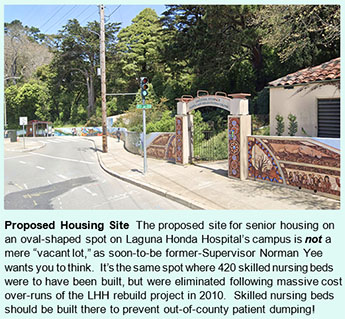 December 30, 2020
December 30, 2020Laguna Honda Hospital Housing Proposal Reduced to 100 Units?
Invisible Affordable Housing on Public Land
Printer-friendly PDF file
 December 30, 2020
December 30, 2020
Laguna Honda Hospital Housing Proposal Reduced to 100 Units?
Invisible Affordable Housing on Public Land
by Patrick Monette-Shaw
The adage “the more things change, the more they stay the same” has never been truer than when it comes to placing 100% affordable housing projects on San Francisco’s public lands.
Back in early 2019, Mayor Breed and her allies started planning to place “Prop. E” on San Francisco’s November 2019 ballot, hoping to convince voters that placing 100% affordable housing or teacher housing projects on public parcels throughout the City would help speed up affordable housing production in the City.
As I wrote in July 2019 (“Breed’s Blank Check: Re-Zoning Public Lands”), Breed and her allies asserted that placing housing on public parcels would save massive amounts of time in gaining approval to get affordable housing projects through the maze of zoning processes in the City and significantly reduce the time it takes get through the proposed projects pipeline.
During her June 11, 2019 press conference, Breed stated, in part:
“When we have an opportunity on public property that’s underutilized to build 100% affordable or teacher housing, we can do it without going through a lengthy two-year re-zoning planning process.”
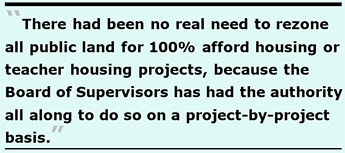 As I reported in July 2019, the San Francisco Chronicle published an article on June 21, 2019 with a sidebar that then showed land-use entitlements and re-zoning typically occur during environmental review of housing project developments during Step 4-A, a step that can take 12 to 24 months. (The sidebar has now vanished from the Chronicle’s web site.) The Chronicle reported that the re-zoning portion of the environmental review is concurrent and simultaneous with detailed design, permitting, and financing steps during the same 12- to 24-month period. Obviously, streamlining the re-zoning portion is not going to streamline the design, permitting, and financing process. Step 4 will still take up to 24 months.
As I reported in July 2019, the San Francisco Chronicle published an article on June 21, 2019 with a sidebar that then showed land-use entitlements and re-zoning typically occur during environmental review of housing project developments during Step 4-A, a step that can take 12 to 24 months. (The sidebar has now vanished from the Chronicle’s web site.) The Chronicle reported that the re-zoning portion of the environmental review is concurrent and simultaneous with detailed design, permitting, and financing steps during the same 12- to 24-month period. Obviously, streamlining the re-zoning portion is not going to streamline the design, permitting, and financing process. Step 4 will still take up to 24 months.
There had been no real need to rezone all public land for 100% afford housing or teacher housing projects, precisely because the Board of Supervisors routinely rezones parcels — and does so relatively quickly. It has approved Special Use Districts in the past. They had that authority to do so all along.
Little has changed in the now nearly two years since Breed began planning her ballot measure, or in the 13 months since voters passed “Prop. E.” The status quo has essentially stayed the same. There was never any real need to re-zone public land Citywide.
Rip Van Winkle Oversleeps
 During 2019 and 2020, the Board of Supervisors took a Rip Van Winkle-size nap. It overslept and just woke up.
During 2019 and 2020, the Board of Supervisors took a Rip Van Winkle-size nap. It overslept and just woke up.
Although the Board of Supervisors claimed to a City Hall source in June 2019 that it “only saw the Mayor’s [re-zoning public land] proposal” the night before she submitted it to the Elections Department on June 18, 2019, on the very same day the Department of Elections had two competing re-zoning measures posted on its web site, both carrying date-stamps of June 18, 2019. One of the two measures included one from four members of the Board of Supervisors (Supervisors Sandra Lee Fewer, Aaron Peskin, Shamann Walton, and Matt Haney).
It’s thought that no public hearings were held at the Board of Supervisors before the four submitted their ballot proposal to the Department of Elections. Instead, it was introduced during a Board of Supervisors meeting on June 18 (on the same day it was submitted to the Elections Department) and assigned to the Board’s Rules Committee. The first hearing on the Board’s ballot measure was heard at its Rules Committee on July 11.
What this suggests is that the four Supervisors had to have been planning to introduce the measure long before June 18 in order to be certified “as to form” by a Deputy City Attorney.
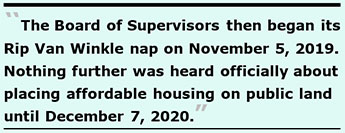 The Board of Supervisors and Mayor Breed finally duked it out, and instead of placing competing ballot measures on the same ballot, Breed withdrew her version and a compromise bill reached voters on November 5, 2019 that voters passed.
The Board of Supervisors and Mayor Breed finally duked it out, and instead of placing competing ballot measures on the same ballot, Breed withdrew her version and a compromise bill reached voters on November 5, 2019 that voters passed.
The Board of Supervisors then began its Rip Van Winkle nap. Nothing further was heard officially about placing affordable housing on public land until December 7, 2020. That’s when the Board of Supervisors Land Use and Transportation Committee (LUT) scheduled a hearing to explore:
“… strategies the City can pursue to maximize the creation of affordable housing on public land, with a goal of 100% affordable, including a review of public land that’s been developed for housing or is under consideration for future development” and other related issues.
Why did the Board wait for at least 13 months to even begin considering strategies? Due to time constraints since the December 7 meeting lasted long, the LUT continued the hearing to its next meeting on December 14. But before the December 7 hearing was adjourned, I was able to testify verbally by calling into the hearing. I testified, in part:
“For at least the last 22 months — nearly two years — the Board of Supervisors has dragged its feet to consider strategies to maximize creating affordable housing on public land, given planning that had been underway as far back as March 2019 (or earlier) to place “Prop E” on the November 2019 ballot.
… So, it’s somewhat ironic that the Board of Supervisors is just getting around to holding today’s hearing to ‘explore strategies to maximize creating affordable housing on public land.’ It’s kind of like Johnny-come-lately coming late to the party, two years late.”
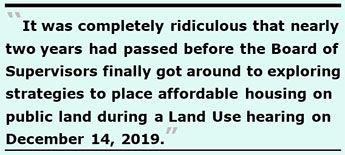 It was completely ridiculous that nearly two years had passed before the Board of Supervisors got around to exploring strategies to place affordable housing on public land. Wasn’t there any urgency?
It was completely ridiculous that nearly two years had passed before the Board of Supervisors got around to exploring strategies to place affordable housing on public land. Wasn’t there any urgency?
I also testified on December 7:
“As part of today’s hearing, I urge the LUT Committee to require that MOHCD rapidly issue an inaugural quarterly report to CGOBOC on planned projects for the 2019 Affordable Housing Bond. Here we are 13 months after passage of the $600 million bond in November 2019, and CGOBOC has not yet received any written reports from MOHCD describing projects planned for any of the various categories of affordable housing promised to voters in the bond.
Yes, 13 months after the bond was passed by voters neither CGOBOC, nor members of the public, nor the Board of Supervisors have any idea of what specific affordable housing projects will receive funding from the 2019 Bond.”
Following my testimony, Supervisor Peskin responded, saying:
“I appreciate the fact that the City, by and through MOHCD — and I’m not responding to the [previous] speaker [Patrick Monette-Shaw] — could communicate better about affordable housing deliveries. Having said that, we actually have a good portfolio to show.”
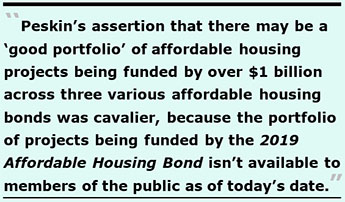 Supervisor Peskin’s rejoinder was wholly inadequate. While he acknowledged Mayors Office of Housing and Community Development (MOHCD) isn’t communicating well — with either members of the public, or with Citizen’s General Obligation Bond Oversight Committee (CGOBOC) who performs oversight of all bonds passed by voters — Peskin’s assertion that there may be a “good portfolio” of affordable housing projects being funded by over $1 billion across three various affordable housing bonds was cavalier, because the portfolio of projects being funded by the 2019 Affordable Housing Bond is not available to members of the public as of today’s date.
Supervisor Peskin’s rejoinder was wholly inadequate. While he acknowledged Mayors Office of Housing and Community Development (MOHCD) isn’t communicating well — with either members of the public, or with Citizen’s General Obligation Bond Oversight Committee (CGOBOC) who performs oversight of all bonds passed by voters — Peskin’s assertion that there may be a “good portfolio” of affordable housing projects being funded by over $1 billion across three various affordable housing bonds was cavalier, because the portfolio of projects being funded by the 2019 Affordable Housing Bond is not available to members of the public as of today’s date.
The Board of Supervisors may have a general idea of proposed projects that may be funded from the first tranche of the 2019 Bond now moving forward, but MOHCD has admitted that documents submitted during the recent bond approval process is not an adequate report of planned bond-funded affordable housing projects.
When the LUT Committee held its continued hearing on December 14, MOHCD presented a PowerPoint presentation that dealt mainly with general criteria for 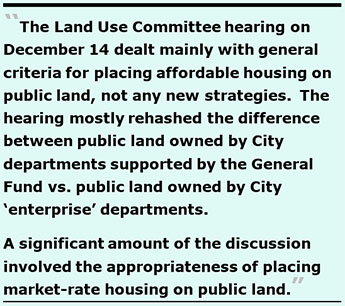 placing affordable housing on public land. And the hours-long hearing on December 14 (available for review on the SFGOV-TV web site) didn’t really explore any new strategies to maximize the creation of affordable housing on public land.
placing affordable housing on public land. And the hours-long hearing on December 14 (available for review on the SFGOV-TV web site) didn’t really explore any new strategies to maximize the creation of affordable housing on public land.
Instead, the hearing was mostly a rehash of the difference between public land owned by City departments supported by the General Fund (which the Board of Supervisors has authority to legislate over) vs. public land owned by City “enterprise” departments — the latter of which are self-supporting departments that do not require or receive General Fund budget allocations from the City budget and whose revenue is restricted on how it can be spent because they generate their own revenues by charging fees for services — which the Supervisors do not have authority to legislate over.
A significant amount of discussion involved the appropriateness of placing market-rate housing on public land. MOHCD prefers mixed-use projects that include market rate housing to help subsidize the cost of building 100% affordable housing projects.
Of interest, during the December 14 hearing an oblique reference was made in passing that soon-to-be-replaced President of the Board of Supervisors, Norman Yee, “may have thought [the Supervisors] didn’t need a hearing to discuss one site that is in progress for affordable housing.” An inquiry has been placed to discover which site Supervisor Yee may have thought it unnecessary to hold a public hearing about.
Following the December 14 hearing, members of the public still have no idea of what specific projects are in the portfolio of affordable housing projects Peskin referred to on December 7.
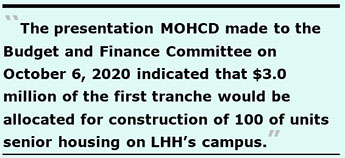 Silence on LHH Housing Proposal
Silence on LHH Housing Proposal
On October 6, the Board of Supervisors Budget and Finance Committee had to hold a hearing to approve moving forward with issuing the first $252.6 million tranche (slice, or portion) of the $600 million 2019 Affordable Housing Bond passed by voters in November 2019. The first tranche has not actually been sold, and it is thought won’t be sold until February 2021.
The presentation MOHCD made to the Budget and Finance Committee on October 6 indicated that $3.0 million of the first tranche would be allocated for construction of 100 of units senior housing on LHH’s campus. The $3 million is most likely for predevelopment expenses.
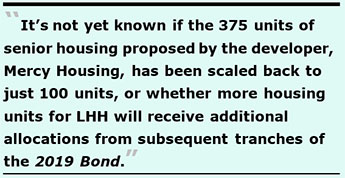 It’s not yet known if the 375 units of senior housing proposed by the developer, Mercy Housing, has been scaled back to just 100 units, or whether more housing units for LHH will receive additional allocations from subsequent tranches of the 2019 Bond. It’s also not yet known whether Mercy Housing has completed its financial feasibility analysis about whether the proposed 375 units are actually financially viable, which feasibility analysis may require Board of Supervisors approval.
It’s not yet known if the 375 units of senior housing proposed by the developer, Mercy Housing, has been scaled back to just 100 units, or whether more housing units for LHH will receive additional allocations from subsequent tranches of the 2019 Bond. It’s also not yet known whether Mercy Housing has completed its financial feasibility analysis about whether the proposed 375 units are actually financially viable, which feasibility analysis may require Board of Supervisors approval.
To date, no public hearings have been held on the LHH housing proposal by either the Board of Supervisors or by the Department of Public Health’s Health Commission, which owns the land at LHH.
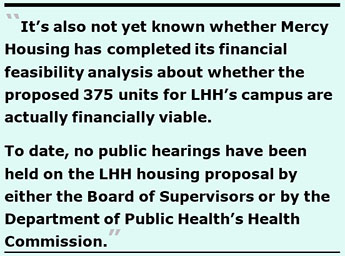 Of note, MOHCD and the Board of Supervisors had sold the first tranche of the $310 million 2015 Affordable Housing Bond on October 19, 2016, 12 months after voters approved the 2015 Bond. It appears the first tranche of the 2019 Bond will take at least 16 months before it is actually sold. There has been no explanation of why it is taking significantly longer for the first tranche of the 2019 Bond to be sold, and whether the delay may be COVID-related.
Of note, MOHCD and the Board of Supervisors had sold the first tranche of the $310 million 2015 Affordable Housing Bond on October 19, 2016, 12 months after voters approved the 2015 Bond. It appears the first tranche of the 2019 Bond will take at least 16 months before it is actually sold. There has been no explanation of why it is taking significantly longer for the first tranche of the 2019 Bond to be sold, and whether the delay may be COVID-related.
Also of note, within eight months of passage of the 2015 Bond, MOHCD issued its second report to CGOBOC on July 28, 2016 identifying projects by name planned to be funded by the 2015 Bond. But here we are 14 months after passage of the 2019 Bond, and MOHCD hasn’t issued to CGOBOC (or to anyone else, including members of the public) a preliminary status report of which projects (by name or location) will be funded by the 2019 Bond.
MOHCD claims it has not issued an initial report of proposed 2019 Bond-funded projects because the first 2019 Bond tranche hasn’t been issued. This stands in stark contrast, because MOHCD had released a report of 2015 Bond-funded projects at least three months before the first tranche of the 2015 Bond was issued. Why did MOHCD make a sudden change in its processes?
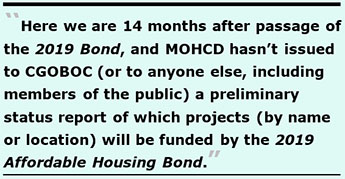 Is this something else that soon-to-be former-Supervisor Yee may have thought unnecessary, because it would alert memers of the broader public of his pet LHH housing project, which is an inappropriate location for seniors and people who are disabled?
Is this something else that soon-to-be former-Supervisor Yee may have thought unnecessary, because it would alert memers of the broader public of his pet LHH housing project, which is an inappropriate location for seniors and people who are disabled?
Monette-Shaw is a columnist for San Francisco’s Westside Observer newspaper, and a member of the California First Amendment Coalition (FAC) and the ACLU. He operates stopLHHdownsize.com. Contact him at monette-shaw@westsideobserver.com.